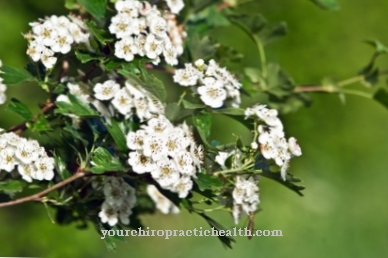Occurrence & cultivation of the rockrose

Rock roses reach a height of around one meter and stand out due to their bushy bushes with strong branching. They prefer to thrive on dry, stony surfaces, the soils of which are usually poor in lime and nutrients. They occur all over the Mediterranean. The greatest biodiversity is in their homeland, and they grow mainly in the garigue, a Mediterranean shrub heather formation that is particularly common in France, Italy and North Africa.
The flowers, from white to pink to purple, often only bloom for a few hours. However, a single shrub is covered with hundreds of flowers, so that an abundant flowering of bush flowers develops between April and June. About 24 species of the genus Cistus are known, plus a large number of hybrids. The more well-known rockrose species include the white rockrose from the western Mediterranean, the Montpellier rockrose, which is native to the Canary Islands and east of Cyprus, or the lacquer rockrose, which occurs in France, the Iberian Peninsula, Morocco and Algeria.
In Central Europe, the Gray-haired rockrose, Cistus incanus, brought into focus as a medicinal plant. The special thing about the plant is the labdanum, which emerges from the leaves and branches when exposed to sunlight. Labdanum is an aromatic, oily resin. The name comes from the Syrian-Phoenician language area, where the rock rose as Ladan, sticky herb. The resin was used as a remedy and for beauty care, the ancient Egyptians used it for smoking.Effect & application
In its home around the Mediterranean, the rock rose has been a well-known remedy for centuries. It is used against infections, bronchial diseases, eye diseases and to stop bleeding. In Central Europe, the gray-haired rock rose is of interest, because research has shown that it is one of the medicinal plants richest in polyphenols. Polyphenols are secondary plant substances with a high antioxidant effect. The antiviral effect of the plant is particularly discussed. For example in connection with Lyme disease, which is caused by ticks.
Even at an advanced stage, the medicinal plant seems to still achieve its effect. Current studies suggest an antiviral effect in flu illnesses. The rockrose could thus become an alternative to the flu vaccination. And at the same time serve to prevent bird and swine flu. The polyphenols of rockrose, which include flavonoids and tannins, can prevent viruses from docking. In doing so, they lock in the virus in order to prevent the pathogens from entering the cell, where a harmful oxidation process of the cells would otherwise start.
The high polyphenol content not only stops the oxidative processes, but also has an anti-inflammatory and cancer preventive effect. In addition, the rockrose is said to have an immune-boosting defense. In addition to the antiviral effect, the medicinal plant fights against bacteria and fungi, curbs inflammation, and is helpful for allergies, skin problems and eczema. Other ingredients, such as the vegetable oils cineol and eugenol, have an expectorant, analgesic and antibacterial effect on the upper and lower respiratory tract in the case of colds.
The cistus is apparently particularly effective in prophylactic use. However, it should be taken no later than 48 hours after the onset of symptoms. The medicinal plant also develops its effect against heavy metals. As with viruses, the polyphenols enclose heavy metals such as cadmium, which enter the gastrointestinal tract. This prevents the harmful substances from being passed into the bloodstream and thus into other organs, and the substances are excreted instead. The polyphenols can clearly distinguish which mineral compounds are useful to the organism and which are not, because they do not bind iron.
Importance for health, treatment & prevention
Even if the effects of rock rose have been researched intensively for a long time and the healing effects are undisputed, no standardized finished medicinal products are yet available. And compared to other medicinal plants, there are only a few studies. The quality of the active ingredient has also not yet been laid down in a pharmacopoeia. The wide range of effects is still well known.
At least the dried herb, which consists of stems, leaves and flowers, is available in the pharmacy, where lozenges or other tablets with the active ingredient are also offered. The easiest way to prepare a rockrose tea, which is drunk to prevent colds, to treat inflammation in the throat or to remove heavy metals. For this, a tablespoon of rockrose herb is poured over with a cup of boiling hot water. Let the mixture simmer for about five minutes, then strain and drink. For skin diseases, a bath with a rockrose decoction is recommended. Also compresses or washes with the stock are recommended.
To do this, simmer ten grams of tea in 200 ml of water for about five minutes, then apply the brew twice a day with a sponge and let it dry. Drink a cup of rockrose tea at least once a day. So far, cistus therapy has shown an amazing effect on neurodermatitis, and it can also be used to treat acne. The medicinal plant is also successful in the fight against herpes simplex viruses, which tend to spread around the mouth and nose in the case of colds. A four-week course is recommended to strengthen the immune system. Drink one liter of tea throughout the day, the first cup in the morning on an empty stomach.
























.jpg)



